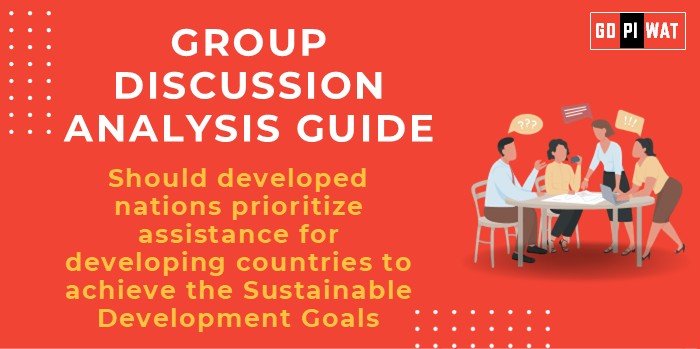📋 Group Discussion Analysis Guide
🌍 Should Developed Nations Prioritize Assistance for Developing Countries to Achieve the Sustainable Development Goals (SDGs)?
💡 Introduction to the Topic
🌱 Opening Context: The 17 Sustainable Development Goals (SDGs), adopted by the United Nations in 2015, serve as a global blueprint to eradicate poverty, protect the planet, and ensure peace and prosperity by 2030. Achieving these goals is especially challenging for developing nations due to financial and resource constraints. This raises the question: Should developed nations prioritize aid to these countries?
📜 Topic Background: The SDGs encompass areas like poverty reduction, health, education, and climate action. While developed countries have resources to implement such agendas, developing nations often depend on international support, creating a dependency that is both a challenge and an opportunity for global collaboration.
📊 Quick Facts and Key Statistics
- 🌍 Global Poverty: Over 700 million people still live on less than $1.90 a day, most in developing regions.
- 💰 Funding Gap: The UN estimates a $2.5 trillion annual financing gap to achieve SDGs in developing countries.
- 🌱 Carbon Emissions: Developing nations contribute ~37% of global emissions but face 70% of climate-related damage costs.
- 📉 ODA Levels: Official Development Assistance (ODA) from developed nations was $204 billion in 2022, far below the UN target of 0.7% of GNI.
🌍 Stakeholders and Their Roles
- 🏛️ Governments (Developed Nations): Provide funding, technology transfer, and expertise to aid SDG implementation.
- 🏢 Governments (Developing Nations): Ensure effective utilization of aid and implement local policies aligning with SDGs.
- 🌐 International Organizations: Facilitate collaboration, provide frameworks, and monitor progress.
- 🏭 Private Sector: Invest in sustainable projects and foster innovation for SDG-aligned solutions.
- 🤝 Civil Society and NGOs: Advocate for inclusivity, transparency, and accountability in SDG initiatives.
🏆 Achievements and Challenges
🌟 Achievements:
- ✔️ Eradication Efforts: Extreme poverty reduced globally by over 30% since 1990.
- ⚕️ Health Initiatives: Vaccination programs funded by developed nations have saved millions in developing countries.
- 🌍 Climate Action Support: Developed countries pledged $100 billion annually for climate financing.
- 🔋 Technology Transfer: Solar energy initiatives in Africa, backed by European nations, have transformed energy access.
⚠️ Challenges:
- 📉 Funding Deficits: Most developed countries fall short of ODA targets, impeding SDG progress.
- ⚔️ Political Dependency: Aid often comes with conditions that limit sovereignty.
- 🌐 Global Comparisons: Nordic nations like Sweden exceed ODA targets, while major economies like the US fall short.
- 📜 Case Studies: Rwanda utilized international funds effectively to boost education and health, whereas some nations misuse aid due to corruption.
✨ Structured Arguments for Discussion
- 💬 Supporting Stance: “Developed nations have a moral obligation to assist, as their historical actions often contribute to current disparities.”
- ⚖️ Opposing Stance: “Aid dependency stifles innovation and self-reliance in developing countries.”
- 🔄 Balanced Perspective: “International assistance should complement domestic initiatives, ensuring empowerment rather than dependency.”
🎯 Effective Discussion Approaches
📖 Opening Approaches:
- 📜 Quote Nelson Mandela: “Overcoming poverty is not a gesture of charity; it is an act of justice.”
- 📊 Start with a compelling statistic: “A $2.5 trillion funding gap jeopardizes SDG success in developing nations.”
🔄 Counter-Argument Handling:
- ✔️ Acknowledge skepticism about aid misuse and suggest accountability measures like UN oversight.
- 🌍 Highlight successful examples like the Global Fund for AIDS, Tuberculosis, and Malaria.
📈 Strategic Analysis of Strengths and Weaknesses
- 💪 Strengths: Fosters global stability, reduces inequality, and addresses pressing global challenges.
- ⚠️ Weaknesses: Risk of aid misuse, geopolitical tensions, and dependency issues.
- 💡 Opportunities: Encourages partnerships and innovation in green technologies.
- 🚨 Threats: Political instability in recipient nations and donor fatigue.
📚 Connecting with B-School Applications
- 🌟 Real-World Applications: Link to project themes on international finance, sustainable development, or global strategy.
- 💬 Sample Interview Questions:
- “How can developed nations ensure aid effectiveness in SDG-focused projects?”
- “Should businesses in developed nations have mandatory SDG investment targets?”
- 📖 Insights for Students:
- Focus on innovative financing models like impact investing and public-private partnerships.


